The NZXT Kraken Z63 & X73 AIO Cooler Review: Shiny On Top, Solid Underneath
by E. Fylladitakis on August 19, 2020 11:00 AM ESTTesting Results, Maximum Fan Speed
Our maximum speed testing is performed with both the fans and the pump of the kit powered via a 12V DC source. This input voltage should have the pump and fans matching the speed ratings of the manufacturer. NZXT states that the 120 mm fans of the X73 have a rotational speed of 2000±300 RPM and the 140 mm fans of the Z63 a speed of 1800±300 RPM. What really stands out from these specifications is the very high-speed tolerance – a >15% tolerance definitely is not common amongst quality products. According to our tachometer, the 120 mm and 140 mm fans were rotating at about 1870 RPM and 2120 RPM respectively, well within their rated specifications. There were some speed differences between identical fans but these did not exceed 100 RPM, which is a little high but not dramatic.

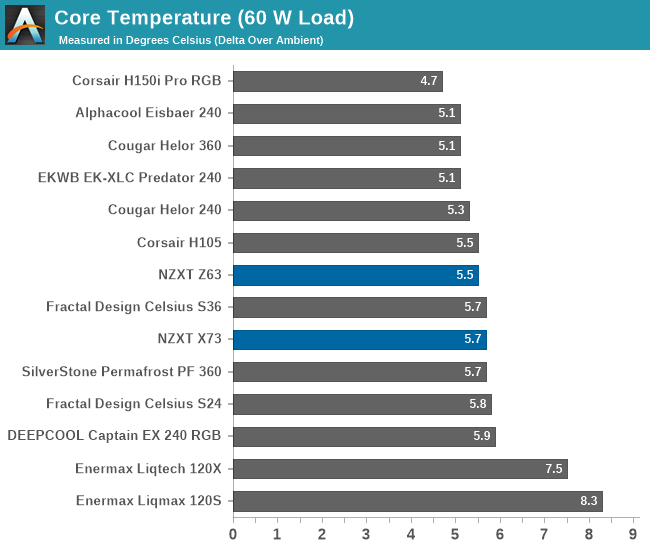
| Core Temperature, Constant Thermal Load (Max Fan Speed) |
The NZXT X73 stands out in our charts, as it manages to overtake every other similarly-sized AIO cooler that we have tested to this date. It has an average thermal resistance of 0.0719 °C/W, which is very good, but that comes with a sound pressure level of 42.9 dB(A), a figure that is definitely on the high side when compared to other, similar solutions. Although the X73 seems to be falling slightly behind when the thermal load is low, it is very efficient when having to cope with high loads, making it one of the best AIO coolers for handling large thermal loads.
Meanwhile the Z63, despite the use of 140 mm fans, falls behind in terms of cooling performance. With an average thermal resistance of 0.0751 °C/W, the Z63 performs well enough, but its thermal performance is fairly close to other coolers with smaller 240 mm radiators; so the Z63's extra size doesn't seem to be helping it much. Past this, like the X73, the Z63 does not stand out when the thermal load is low, but it is significantly more efficient when the thermal load is very high.
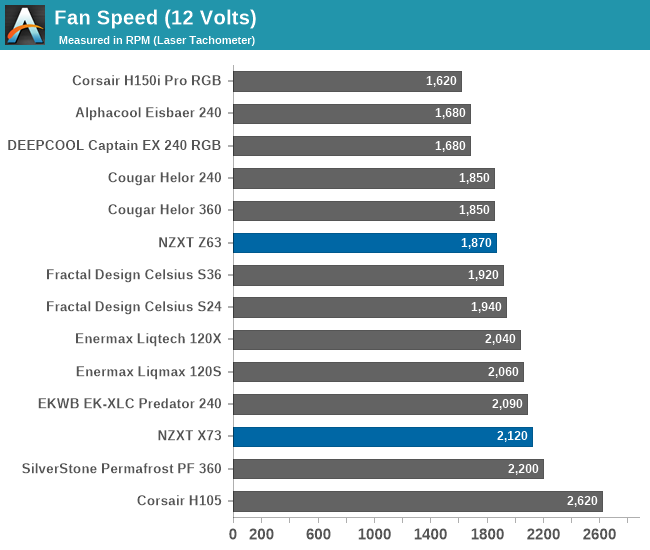
The Z63 does come with one upside, however: with a sound pressure level of 39.8 dB(A), noise levels are notably lower than those from the X73.
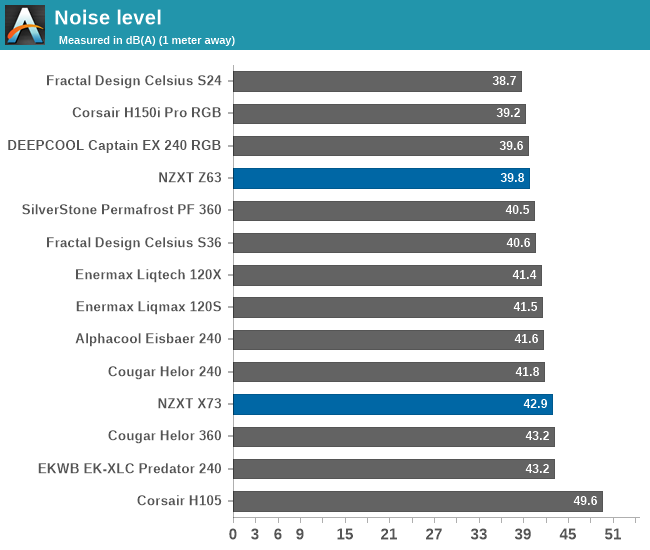
Testing Results, Low Fan Speed
Using a PWM voltage regulator, we reduced the speed of the fans manually down to half their rated speed. At this setting, the 120 mm fans of the X73 and the 140 mm fans of the Z63 rotate at 1240 RPM and 1050 RPM respectively. The pumps were also connected on the same power source, functioning properly at this low speed setting.

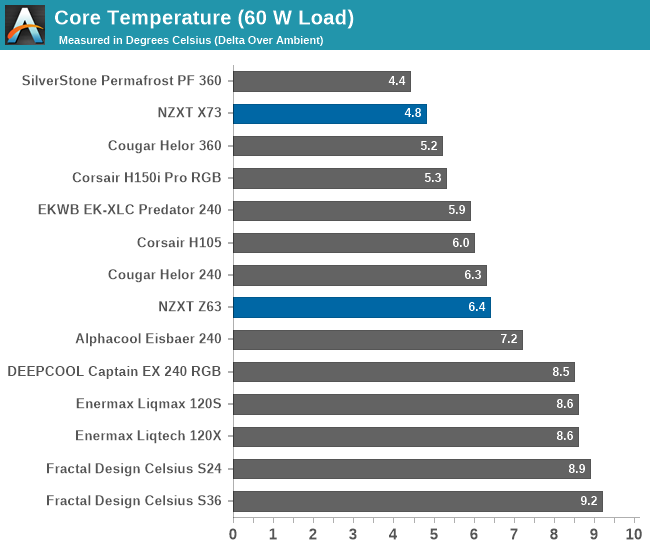
| Core Temperature, Constant Thermal Load (Low Fan Speed) |
NZXT’s X73 once again stands out with an average thermal resistance of 0.0812 °C/W, the best average figure that we have recorded from any AIO cooler to this date. The thermal resistance of the X73 is virtually stable regardless of the load with its pump and fans operating in this state, surpassing most other AIO coolers in any scenario.
However when we check our sound level meter, we measure a sound pressure of 37.4 dB(A), a relatively high figure compared to other coolers. That is mostly because of the high speed and high static pressure nature of the fans, which creates aerodynamic noise. That said, the cooler can certainly operate at lower noise levels if connected to a dynamic control system, such as any modern motherboard that would allow full control over the speed of its fans and pump, but at the obvious expense of thermal performance.
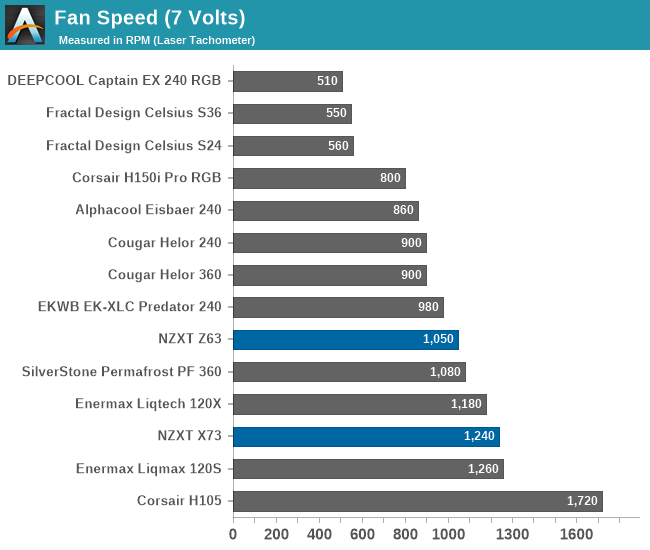
The NZXT Z63 also performs well in our low-speed testing. With an average thermal resistance of 0.0935 °C/W, the 280 mm cooler manages to get dangerously close to many larger AIO coolers, and even surpasses a few of them. Although the mediocre results we got from low load testing initially misguided us into believing that the Z63 will fall far behind the competition, it proved to be very efficient at handling heavy loads. Meanwhile the 35.1 dB(A) of noise coming from the cooler should be tolerable for the majority of home PC users.
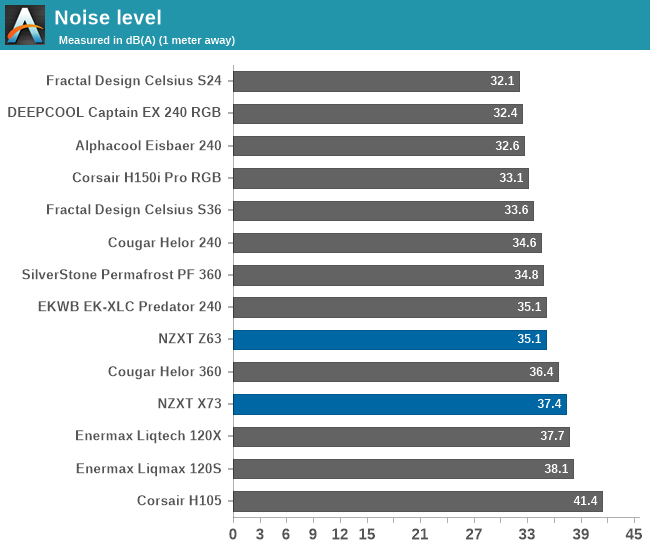
Thermal Resistance VS Sound Pressure Level
During our thermal resistance vs. sound pressure level test, we maintain a steady 100W thermal load and assess the overall performance of the coolers by taking multiple temperature and sound pressure level readings within the operating range of the stock cooling fans. The result is a graph that depicts the absolute thermal resistance of the cooler in comparison to the noise generated. For both the sound pressure level and absolute thermal resistance readings, lower figures are better.
This graph reveals very interesting information. We can see that the NZXT X73 surpasses the absolute thermal resistance of all other 360 mm radiator coolers and also is quieter than Cougar’s Helor and the older Celsius S36. But it is slightly louder than the PF 360 at any given level of thermal performance.
More interesting, perhaps, is the NZXT Z63. It may trail the thermal resistance of the X73 by a small margin, but it manages the same level of thermal performance with significantly less noise. The thermal resistance to sound pressure level curve is steep and suggests that the Z63 can, at the expense of higher noise levels, even outperform the 360 mm coolers if paired with more powerful 140 mm fans.


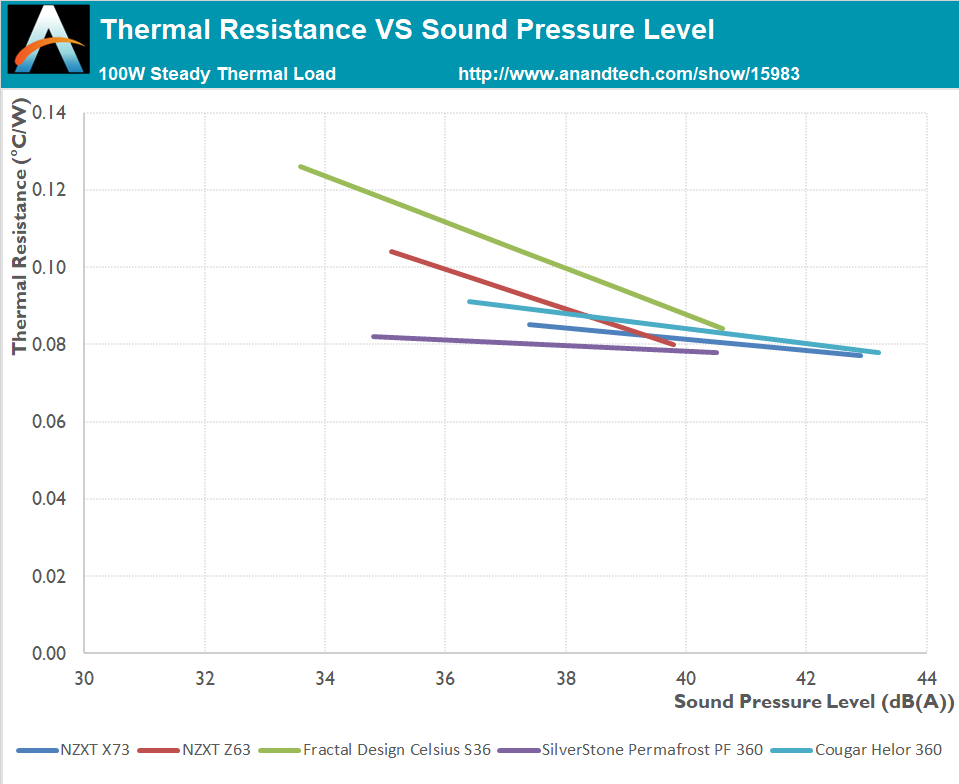








61 Comments
View All Comments
whatthe123 - Wednesday, August 19, 2020 - link
arctic and EK have released non-asetek coolers recently and both of them outperform practically every asetek cooler on the market, especially in price. I don't think asetek rebrands are the only choice anymore as long as you can get your hands on a freezer 2 or ek drgb.edzieba - Thursday, August 20, 2020 - link
In the US, Asetek swings their legal muscle around to quash competition. Elsewhere in the world, there are plenty of other AIO designs available.jaggedcow - Wednesday, August 19, 2020 - link
Minor point but I found it odd how they were dinged for not including threadripper mounting then in the next paragraph the reviewer says it’s not designed for threadripper‘s die size and that they wouldn’t recommend using it with a threadripper CPU. So why are we dinging NZXT for not including mounting hardware for a CPU that this cooler isn’t designed for and a configuration that the reviewer themselves doesn’t recommend? If anything, including a TR4 mount would imply that it WAS designed to also cool that chip.Ryan Smith - Wednesday, August 19, 2020 - link
"So why are we dinging NZXT"To be sure, NZXT is not being dinged. We're just noting that while NZXT advertises these coolers as being able to work with Threadripper, they don't do so out of the box. (And even if they did have the part in the box, we wouldn't suggest it)
Machinus - Wednesday, August 19, 2020 - link
Ian, can you ebalorate on how usable the X73 is without having to use the CAM software? Can the fan and pump be controlled with typical BIOS headers?satai - Wednesday, August 19, 2020 - link
Is it better then high end air coolers?inighthawki - Wednesday, August 19, 2020 - link
The 360mm and 280mm radiator coolers tend to be give or take with high end air coolers, and generally cost more. The 240mm radiators are almost always worse, more expensive, and louder.The largest advantage of these is often not the improved temps, but how they mount in the case. The higher end air coolers tend to be extremely bulky and can have some difficulties fitting in smaller or more compact cases, or can have compatibility issues with ram depending on the ram height and motherboard layout.
Luminar - Wednesday, August 19, 2020 - link
Repeat after me: all water cooling solutions eventually leak.Lord of the Bored - Wednesday, August 19, 2020 - link
[citation needed]Spunjji - Thursday, August 20, 2020 - link
On a long enough timescale? Sure.Within the lifetime of one or even two system builds? No, not in my experience.
Can't comment for longer durations than that, as the oldest kit I've personally seen in service is about 7 years old now.